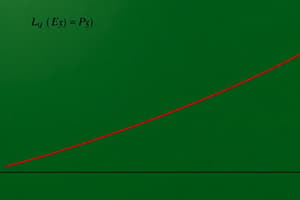Podcast
Questions and Answers
What happens to the marginal cost curve (MC) when the wage rate or another component of variable cost increases?
What happens to the marginal cost curve (MC) when the wage rate or another component of variable cost increases?
- Shifts upward (correct)
- Shifts in the opposite direction
- Remains unchanged
- Shifts downward
When there's a technological change that increases productivity, what happens to the average cost curve (AP)?
When there's a technological change that increases productivity, what happens to the average cost curve (AP)?
- Shifts upward
- Shifts horizontally
- Remains unchanged
- Shifts downward (correct)
In the long run, what major decisions can a firm make regarding factors of production?
In the long run, what major decisions can a firm make regarding factors of production?
- Limit variable costs
- Decide on the level of fixed costs
- Select only labor-intensive operations
- Decide on the scale of operations and whether to be capital or labor intensive (correct)
How does a technological improvement impact short-run cost curves?
How does a technological improvement impact short-run cost curves?
What effect does a technological change that increases productivity have on the total product curve (TP)?
What effect does a technological change that increases productivity have on the total product curve (TP)?
In the long run, why is the law of diminishing returns considered irrelevant?
In the long run, why is the law of diminishing returns considered irrelevant?
In the long-run planning of a firm, which of the following cost structures is most relevant?
In the long-run planning of a firm, which of the following cost structures is most relevant?
What principle guides a firm into choosing the optimal factor mix in the long run?
What principle guides a firm into choosing the optimal factor mix in the long run?
When does a firm find it optimal to be labour-intensive in a labour abundant country?
When does a firm find it optimal to be labour-intensive in a labour abundant country?
Which factor of production is considered fixed in the short run?
Which factor of production is considered fixed in the short run?
What is the relationship between total product (TP), marginal product (MP), and average product (AP) as diminishing returns set in?
What is the relationship between total product (TP), marginal product (MP), and average product (AP) as diminishing returns set in?
What is the main difference between the short run and the long run in terms of costs?
What is the main difference between the short run and the long run in terms of costs?
What determines the number of firms operating in an industry?
What determines the number of firms operating in an industry?
When increasing returns persist for very large output levels, what is the tendency in an industry?
When increasing returns persist for very large output levels, what is the tendency in an industry?
What does a firm seek to equate for all factors of production in the long run?
What does a firm seek to equate for all factors of production in the long run?
What is shown by the long-run average cost curve?
What is shown by the long-run average cost curve?
What may a firm experience as it increases its production scale?
What may a firm experience as it increases its production scale?
What is the term for an industry where only one firm operates and average costs are minimized?
What is the term for an industry where only one firm operates and average costs are minimized?
Study Notes
- Number of firms in an industry is influenced by cost structure, with constant returns to scale allowing small and large firms to coexist.
- Industry with increasing returns over small output levels may have many small firms, while industries with increasing returns at large output levels can lead to a natural monopoly.
- Examples of industries with constant returns to scale include furniture, food processing, and small appliance industries.
- Examples of industries with a wide range of constant returns to scale include the motor industry, chemical plant and steel industries, as well as ICT companies like Google, Apple, IBM, and Microsoft.
- In the long run, firms make decisions based on the marginal decision rule to minimize costs and choose the optimal factor mix, considering economies of scale and factors of production.
Studying That Suits You
Use AI to generate personalized quizzes and flashcards to suit your learning preferences.
Description
Learn about long-run planning and costs in economics, where all factors and costs are considered variable. Explore the structure of costs, returns to scale, and the concept of economies of scale.




